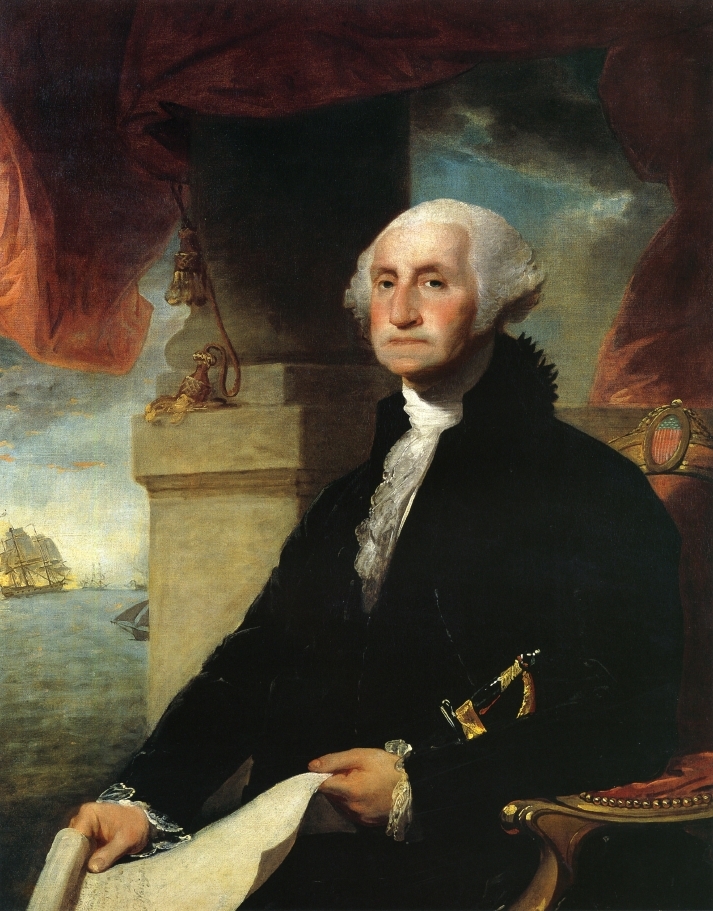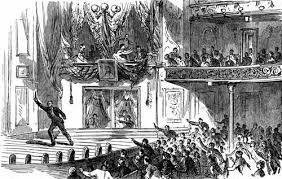“I feel my self going. I thank you for your attention. You had better not take any more trouble about me; but let me go off quietly; I cannot last long.”1 These were George Washington’s dying words. Who could have imagined that this great Revolutionary War hero and first President could fall two years after his retirement? He seemed to be immortal in the public’s eyes. Staying in the spotlight for nearly twenty five years, standing as the symbol of American nationhood, he not only had stood as a symbol of America, but he had also commanded the armies that helped gain national independence. After all the wars, he never appeared fazed, never showed any type of weakness or vulnerability, until that frigid winter of 1799.2
The century was nearly over, and the future of the young nation seemed bright. The former commander-in-chief of the nation had retired to his estate of Mount Vernon and had set out on horseback to check on certain areas of his plantation. It was December 12, 1799.3 He was exposed to cold rain and snow, but that did not stop this man from carrying out his responsibilities. However, sometimes carrying out responsibilities can have serious consequences. The next day he woke early in the morning, having difficulty breathing. Later in the morning he started to developed pain in the throat, and this led him to be unable to swallow or speak well. He grasped for some air, constantly tossing and turning to find a comfortable position.4 Lying down in agony, he was surrounded by three physicians who were all at a loss as to what to do.
James Craik, Gustavus Richard Brown, and Elisha Cullen Dick were the attending physicians for Washington, and all knew him very well.5 The first to arrive was Dr. Craik on Friday, December 13, when Washington started first experiencing a cold with a light hoarseness. By 2 a.m. the next morning, he awoke with troubled breathing. At 6 a.m. he was showing signs of a fever with throat pain and respiratory suffering.6 Washington was unable to swallow and even had difficulty speaking. Dr. Craik believed that the only option for Washington was for a bloodletting.
Bloodletting is the surgical removal of blood from a patient, and it was a typical procedure physicians used in the eighteenth century. Typically, the physicians were not the ones that would carry out the bloodletting; they would call in a skilled bloodletter. In this case, the bloodletter was George Rawlins. At 7:30 a.m., Rawlins removed about 12 to 14 ounces of Washington’s blood. Washington actually requested an additional bloodletting. Two hours later, Dr. Craik applied a blister of cantharides to Washington’s throat and removed roughly 18 more ounces of blood. This was also done at 11 a.m.7 Washington was still alert at this time. He even had the strength to stand up and walk to the bathroom, but he still had trouble swallowing tea, nearly suffocating from the attempt and unable to cough up the fluid.
There was an argument among the physicians caring for Washington, whether there should be a fourth bloodletting. Dr. Elisha Cullen Dick believed that more bloodletting would make Washington’s condition worse. Nevertheless, Dr. Craik ordered for the bloodletting at 3 p.m.8 After the fourth bloodletting, Washington seemed to show improvement; he was able to swallow. With renewed strength, Washington was able to revise his will. He knew his time was coming to an end. As the night continued, his condition steadily worsened. The physicians tried their best to keep him stable by applying blisters of cantharides to his arms, legs, and feet. They even applied wheat-bran cataplasms to his throat.9 This did stop his condition from worsening.

At 10 p.m., Washington whispered his burial instructions to his aide. Twenty minutes later, George Washington died. The news of his death spread rapidly across the country. The grieving was not only at his at burial site, but across the Atlantic. There was a London newspaper that eulogized: “His fame, bounded by no country, will be confined to no age.”10 Units of the British fleet that was blockading a harbor in France dropped their ensigns to half-mast. Napoleon ordered a ten-day requiem.11 In the United States, newspapers would publish poems from grieving women. People traveled to Mount Vernon to pay their respects. Citizens dressed in black clothing for months.12
December 26 was the official day of mourning. At dawn, there were sixteen cannons that were fired, and they continued to boom every half hour until 11 a.m. After the firing of the cannons, there was a march of troops to the Lutheran Church where Henry Lee gave a memorial of Washington that became immortal: “First in war, first in peace and first in the hearts of his countrymen, he was second to none in the humble endearing scenes of private life…The purity of his private character gave effulgence to his public virtues.”13 To pay tribute to the first president, Congress voted to construct a marble monument in the Capital building, which was still under construction in Washington, D.C. at the time. This was an appropriate tribute to a great man, and he will forever be immortal in our nation’s history.
- Salem Press Encyclopedia, January 2016, s.v. “George Washington’s Death.” ↵
- Salem Press Encyclopedia, January 2015, s.v. “George Washington,” by David Curtis Skaggs. ↵
- Salem Press Encyclopedia, January 2016, s.v. “George Washington’s Death.” ↵
- David M. Morens, “Death of a President,” New England Journal of Medicine, vol. 341, (December 1999): 1845. ↵
- David M. Morens, “Death of a President,” New England Journal of Medicine, vol. 341, (December 1999): 1845-1849. ↵
- David M. Morens, “Death of a President,” New England Journal of Medicine, vol. 341, (December 1999): 1845. ↵
- David M. Morens, “Death of a President,” New England Journal of Medicine, vol. 341, (December 1999): 1845. ↵
- David M. Morens, “Death of a President,” New England Journal of Medicine, vol. 341, (December 1999): 1845. ↵
- David M. Morens, “Death of a President,” New England Journal of Medicine, vol. 341, (December 1999): 1846. ↵
- Salem Press Encyclopedia, January 2016, s.v. “George Washington’s Death.” ↵
- Salem Press Encyclopedia, January 2016, s.v. “George Washington’s Death.” ↵
- David M. Morens, “Death of a President,” New England Journal of Medicine, vol. 341, (December 1999): 1846. ↵
- Salem Press Encyclopedia, January 2016, s.v. “George Washington’s Death.” ↵



73 comments
Richard Navarro
I think it’s amazing how men back then were so much mature and more strong than men now. They complained about very little and appreciated even the smaller. Washington impacted many people around the world. Even some of his enemies. That is true leadership if you ask me. Washington was a man of truth, and determination for greatness. Bloodletting sounded very painful, I can only imagine what he went through.
Abigale Carney
This was a very informative article. I have never heard of bloodletting. The bloodletting process sounded very painful. Having to release more than 14 oz. of blood from Washington’s throat made his death seem very long and painful. It is sad to hear of stories when people know they are going to die, Washington was very mature about his death which truly shows us the kind of man he was.
Eduardo Foster
Really nice article! The importance George Washington has in the United States is huge. I didn’t actually know how George Washington died. I loved how you open the article with George Washington’s words. It is actually very inspiring and is a man that would never be forgotten by American society. Actually great article and keep it up with the good work!
Edith De Loera
We are all aware, and were often taught of all the achievements of the first president, George Washington, but I imagine very few know of the vulnerable moment of his death. I realize many of the readers, including myself, did not know much about bloodletting but this article perfectly filled us in. How unfortunate for a great leader to die in such a slow, painful way. Thank you taking us back to the1840’s with this story.
Oceane Roux
I really enjoyed reading this article. George Washinton was a hero and impacted the United States forever. I can’t imagine how people reacted when they heard about his death. The author does a great job transmitting the emotions to the reader. I think that Washington’s life is fascinating and his last words are truly inspiring in the image of the man.
Kelley Salinas
George Washington was one of the greatest American presidents known to man. Because he was the first, he also set many precedents for the following leaders to come. He was a beacon of hope for his new American citizens. It’s unfortunate to hear that after pains, trials, and wars won this strong American hero fell to the inevitable. It only goes to show that we are all human.
Cristian Medina-Lopez
In this article, I thought it was very important and useful the way they used George Washington’s last words as an opener to hook the audience. I think it’s incredible the influence he had on the rest of the young country that he had helped create. The author also did a good job on how he mad the tone of the article feel as if we were there ourselves.
Megan Barnett
Very interesting article I had no idea how George Washington died. I liked how you described what bloodletting was because I was not exactly sure, however you did included other medical terms that I was not familiar with. Overall your article was written very well with detail that clearly explained what happened before, during, and after Washington’s death. What really surprised me though was that newspapers had actually published poems from grieving women.
Nahim Rancharan
Wow! This was a very interesting article. I knew about George Washington, but not about his death. It is amazing how one of the most important men in American History showing signs of strenght and valor could, in reality, have died in a way that shows weakness and vulnerability. This was a new side of Washington that I never knew about. I like how the introduction started of with his last words and to me, they seemed very poetic. The article was very detailed and very interesting to read. It was excellently organized and interesting to see how a simple fever had resulted into bloodletting, which unfortunately resulted in the death of America’s most famous hero and founding father. Excellent Work!
Sergio Cervantes
The introduction to this article captivated me instantaneously! I found it interesting to read an article over the final moments of our first president. A great life this man lived as the leader of our continental army and first president. How stressful things must have been which eventually took their toll on his health. It is great to see that he was given a military funeral with the shot of cannon in the background as they laid his body to rest in the Earth.